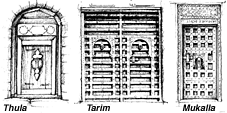
The old Yemeni Wooden front-doors [Archives:1999/07/Last Page]
February 15 1999

However I did not expect to find in the Yemen such an outstanding and old tradition of craftsmanship, which can be found here in a large number of most impressively designed old wooden doors. The exciting aspect herein is the fact that in the course of history each region and even each town has developed its own kind of doors which can be found there alone. Probably this local aspect in the design of wooden front-doors has formerly also existed in other countries and cultures. Yet during my extensive travels through Islamic countries it was only in the Yemen that I came across this expressive form and state of conservation. But this is exactly where the problem comes in which became the reason for my work about Yemeni front-doors: Their decay proceeds at a worrying speed.

The same development has already started, though it is not yet as clearly observable as in the North because of the much higher number of existing carved wooden doors in the former South-Yemen in the Wadi Hadhramaut and its side-valleys or in towns like Mukalla or Asch-Schechr. However you will see in towns like Shibam or Sayun that old wooden doors waiting to be overhauled are no longer repaired. Instead their parts are sold to tourists by dealers in order to give the former owner at least a small profit. For the Yemen these doors are then lost forever. At least one can only hope that through the interest of the tourists the local people become aware not only of the material but also of the cultural value of their property. Yet I am afraid that a change of mind takes too long and that within a few years there will only be fragments of this highly fascinating culture of wooden doors.
This development is the main reason why I started a couple of years ago to document through photos and drawings at least some of the different types of front-doors I came across. I am sure that I have not documented all of them but at least the largest part of traditional types of Yemenite front-doors.
The visit of H.E. the President of State Ali Abdullah Saleh at Bonn in September 1997 gave me opportunity to hand over a small folder containing 25 drawings out of my documentation together with the request for appropriate measures to prevent further damage and decay. I realize of course how difficult it will be to stop the process of advancing decline and I am aware of the fact that the President of the State is at the moment confronted with a lot of more important and urgent problems than the conservation of the old Yemeni wooden front-doors.
Nevertheless I think that it should be possible to make the people in the country aware of the cultural value of their wooden doors. After all, these objects have something to do with their identity as Yemenis. I can well imagine that an exhibition of my drawings might help to change their attitude.
I also think that it is necessary to have a written description of the different types of Yemenite front-doors in a little booklet or in a kind of catalogue to better understand and appreciate the value of these cultural treasures.
________________
Dipl. Gwl. Traugott Whrlin, born in 1931, studied architectural engineering and worked as teacher in several vocational training-centers of Baden-Wrttemberg. Since 1964 he lives and works in Freiburg where he was training young master-cabinet-makers for about 25 years. From 1979 until 1993 he was the headmaster of the “Friedrich-Weinbrenner-Gewerbeschule” in Freiburg, one of the most important training-units for building-professions of all kinds in Baden-Wrttemberg.
Since 1980 he has made many journeys into several Islamic countries where he began to study all kinds of Islamic woodworking crafts. In 1989 he came the first time to Yemen and after his retirement in 1993 he was for two months student of the Yemen Language Center in Sana’a.
——
[archive-e:07-v:1999-y:1999-d:1999-02-15-p:./1999/iss07/lastpage.htm]


